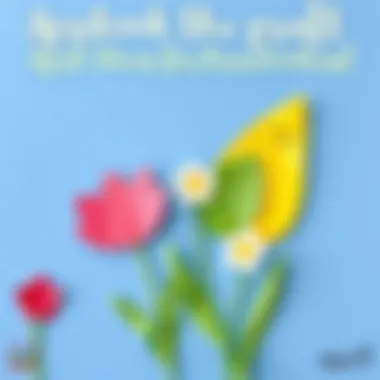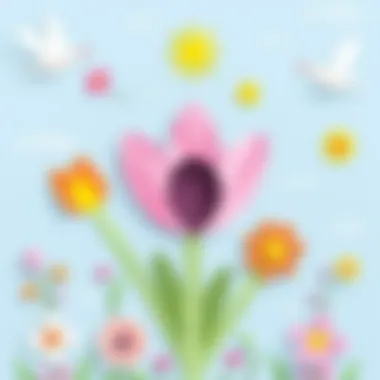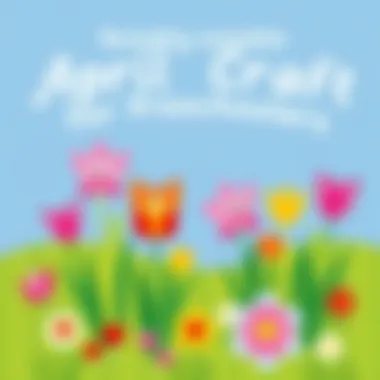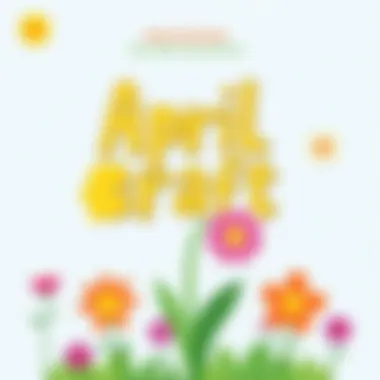Creative April Craft Projects for Preschoolers


Intro
April is a month bursting with color and life, making it an ideal time for preschoolers to embrace their creativity. Engaging in crafts not only provides young children with a fun pastime, but it also plays a significant role in their development. As they manipulate various materials, they enhance their fine motor skills, boost their imaginations, and learn to express their thoughts and feelings. In addition to these developmental benefits, April’s themes offer a rich tapestry for projects, including aspects of nature, holidays like Easter, and education on seasonal changes. This guide aims to bring together an assortment of craft ideas perfect for encouraging the eager little hands of preschoolers.
Nature and Spring Crafts
Spring gives us a front-row seat to nature's revival. The flowers bloom, and colors flourish, making it a perfect canvas for crafting.
Flower Power
Materials Needed:
- Colored paper
- Safety scissors
- Glue
- Pipe cleaners
- Markers or crayons
Steps:
- Trace Flower Shapes: Help the kids trace different flower shapes onto colored paper. This encourages recognition of shapes and colors.
- Cut and Assemble: After cutting out the shapes, children can glue them onto a heavier piece of paper or cardboard for more stability.
- Adding Stems: Bend the pipe cleaners to create stems and position them on the paper also.
- Decorate: Encourage the children to use markers or crayons to draw details on the flowers or background.
Rainbow in a Jar
Materials Needed:
- Clear jar
- Water
- Food coloring
- Oil
Steps:
- Prepare: Fill the jar halfway with water. Add a few drops of food coloring.
- Adding Oil: Slowly pour in some oil on top of the water. Notice how the oil floats.
- Observation: Kids can shake the jar gently and watch the food coloring drop through the oil, creating a rainbow-like effect.
This craft illustrates basic principles of density and color mixing, providing an opportunity for informal science learning through crafting.
Holiday-Themed Crafts
During April, Easter takes center stage for many. Craft ideas based on this theme can be delightful while also turning educational.
Bunny Ears Headband
Materials Needed:
- Construction paper (white, pink)
- Scissors
- Tape or glue
- Stapler
- Headband (or strip of construction paper)
Steps:
- Cut Out Ears: Create two large bunny ears from white construction paper and two smaller inner ear shapes from the pink paper.
- Assemble Ears: Glue the pink shapes onto the white ears and let them dry.
- Attach to Headband: Staple or tape the ears to a headband or strip of paper so they stand upright.
- Personalization: Let children decorate their headbands with drawings or stickers.
Finale
Crafting in April is not just about making pretty things; it’s about fostering a love for creativity, learning, and nature. Whether it's making a flower or a silly bunny headband, every project offers preschoolers a chance to explore their world and express their inner thoughts. These activities require simple materials and can be completed with minimal adult supervision, encouraging independence in young creators. Keep these craft ideas in your back pocket for effortless interactive fun this spring!
For more ideas and inspiration, consider visiting National Geographic Kids or PBS Parents for resources on enriching children's creativity through play.
Preamble to April Crafts
Crafting in April opens the door to a world of creativity and exploration for preschoolers. As the month marks the blooming of nature, it provides an excellent backdrop for engaging young minds through hands-on activities. This time not only enhances creativity but also helps children develop various skills essential for their growth.


Importance of Crafting in Early Childhood
Crafting plays a pivotal role in early childhood development. It’s not just about glue and scissors; crafting fosters fine motor skills, creativity, and cognitive development. When preschoolers engage in crafting activities, they're not merely following directions but also making choices that reflect their individuality. This act of creating allows them to express their thoughts and feelings in a way that words sometimes can’t capture.
When they use their hands to mold, cut, or paint, they develop dexterity and hand-eye coordination. For instance, painting not only encourages artistic expression but also helps little fingers strengthen and refine their motor skills. It can be fascinating to watch how a child who could barely grasp a crayon evolves into a budding artist capable of wielding a paintbrush with confidence.
Key Benefits of Seasonal Crafts
There’s something particularly special about seasonal crafts that resonates with our young learners. Engaging in craft activities that align with the season—like spring in April—heightens awareness of the environment and teaches kids about cycles of nature. For example, crafting a colorful paper flower can help a child understand the concept of growth and renewal.
Moreover, seasonal crafts often incorporate themes around holidays, such as Easter or Earth Day, which can teach valuable lessons. For instance:
- Easter Crafts: These encourage imagination through activities like egg decorating, which can involve intricate designs or simple patterns, thus boosting problem-solving skills.
- Earth Day Initiatives: Projects related to recycling promote environmental consciousness and a sense of responsibility towards nature.
"Crafting isn’t just a leisure activity; it's a learning expedition wrapped in fun."
In summary, incorporating crafts during this season not only nurtures creativity but also widens children's perspectives on the world around them. It’s a chance for exploration, learning, and connection, making April an ideal month for parents and educators to dive into thematic crafting experiences that are simple yet profoundly meaningful.
Materials for Preschool Crafting
Crafting with preschoolers is not just about creativity; it's a journey of discovery and learning. When engaging young minds in hands-on activities, having the right materials is essential. The tools and supplies can make the difference between an ordinary craft session and an extraordinary experience where imagination knows no bounds. Furthermore, choosing appropriate materials aligns with the developmental needs of preschoolers. This section will explore some essential craft supplies as well as eco-friendly alternatives that parents and caregivers can consider.
Essential Craft Supplies
To kickstart a fun crafting adventure, some basic supplies can go a long way. Here’s a concise list of what you might want to gather before diving into creative projects:
- Construction paper: This is a must-have! Available in various colors, it's perfect for cutting, gluing, and making collages.
- Scissors: Safety scissors specifically designed for little hands are your friend here; they can help develop fine motor skills.
- Glue sticks and liquid glue: While glue sticks are less messy, having liquid glue on hand can be handy for certain projects.
- Markers and crayons: These are essential for adding color and details, sparking creativity in young artists.
- Paints: Watercolors and non-toxic acrylic paints bring life to any craft project.
- String and yarn: Great for threading activities, these materials can also be used for textural embellishments.
- Stickers: Easy to use, stickers can enhance nearly any craft and are a fun add-on for children.
- Craft foam: This versatile material is enjoyable to work with and adds dimension to projects.
These supplies form a solid foundation for a myriad of projects and encourage exploration. Let the kids choose which materials excite them the most; it's all about igniting their creativity and making the crafting experience enjoyable!
Eco-Friendly Options
As parents and caregivers become increasingly aware of environmental issues, it's important to consider eco-friendly crafting materials. These options not only minimize waste but also instill values of sustainability in young children. Here are some alternatives to consider:
- Recycled materials: Encourage kids to use items like old newspapers, cardboard boxes, and egg cartons. These can be transformed into anything from robots to bird feeders.
- Biodegradable glitter: A pop of sparkle can be fun, and opting for biodegradable options means they are less harmful to the environment.
- Natural dyes: Instead of synthetic colors, explore using organic materials like beet juice or turmeric for painting, making it safe and eco-friendly.
- Plant-based glues: Some brands offer non-toxic glues made from natural elements, perfect for young crafters.
- Second-hand fabric: Old clothing can become a treasure trove for crafting, providing materials for puppets and other projects.
By utilizing these eco-friendly options, you’re not just creating art but also teaching kids the importance of caring for our planet. Crafting can be fun and responsible at the same time. Remember, each choice reinforces the idea that we can create beautiful things while respecting nature.
"Crafting is not just about making; it's about instilling a sense of responsibility and creativity in our children."
In summary, gathering the right materials is a pivotal step in ensuring that crafting sessions are productive and enjoyable. Whether opting for traditional supplies or embracing sustainable alternatives, the goal is to foster an environment where creativity can flourish.
Thematic Craft Ideas for April
Crafting in April gives preschoolers an opportunity to engage with the vibrant world around them. With the warming weather and blossoming flowers, the thematic craft ideas presented in this section aren't just fun; they're a chance for children to connect with nature and seasonal events. Incorporating themes like nature and holidays into crafting activities encourages not just creativity but also learning. Whether it's the joy of creating something beautiful or discovering the significance of Earth Day, these craft ideas help little ones express themselves while developing essential skills.
Spring Nature Crafts
Flower Art
Flower art stands out as a delightful spring activity that nurtures a child's artistic expression. The freshness of flowers can inspire a wide range of creativity. Kids can use a variety of materials to create vivid representations of flowers, using colors and shapes that speak to their imaginative minds.
One of the beauties of flower art is its versatility; preschoolers can use paints, tissue paper, or even real flowers to create beautiful pieces that brighten any room. The unique feature here is the tactile nature of the materials, which encourages a hands-on experience. However, a potential disadvantage could be some kids might find it challenging to stay within the lines, which is completely fine; it's all about the journey, not the destination.


Leaf Rubbings
Leaf rubbings are a classic craft that allows children to explore textures and shapes found in nature. By placing a leaf under a sheet of paper and coloring over it with crayons, kids get instant, beautiful designs that mirror real-life foliage.
What makes leaf rubbings particularly engaging is the element of exploration involved. Kids can venture outside, collect various leaves, and learn to identify different types—an easy introduction to botany. However, it can require some supervision since leaves can be delicate, but that's just part of the fun!
Easter Crafts
Egg Decorating
Egg decorating is perhaps one of the most loved Easter crafts among preschoolers. Vibrant colors and intricate designs allow kids to express themselves creatively and celebrate the holiday. Using dyes, markers, or stickers, children transform ordinary eggs into unique art pieces, bringing a festive spirit to life.
The key characteristic of egg decorating is its accessibility; most families already have the basic supplies at home. It's a perfect opportunity for bonding, as parents and children can sit together, enjoying the process. The downside? The mess that can ensue, but hey, that's part of crafting!
Bunny Masks
Creating bunny masks offers a playful way to celebrate Easter while engaging in imaginative play. Cardstock, craft sticks, and furry materials can easily come together to form delightful bunny faces. The unique feature of bunny masks is the engagement in role-play that follows. Kids can don their masks and hop around, exploring their creativity.
One consideration to keep in mind: crafting involves cutting and gluing, so adult supervision is essential to keep little hands safe.
Earth Day Awareness
Recycle Crafts
Recycle crafts play a vital role in educating preschoolers about sustainability while promoting hands-on creativity. Utilizing everyday items like plastic bottles or cardboard boxes, children can create exciting projects that turn trash into treasure. This not only fosters creativity, but it also plants the seeds of environmental responsibility early on.
A significant advantage to recycle crafts is that it empowers kids to rethink waste. However, collecting materials might take extra effort—something to consider when planning a crafting session.
Nature Collages
Nature collages present a fantastic opportunity to use materials kids gather during outdoor play. Collecting twigs, leaves, and flowers to assemble a collage can deepen their connection to the environment. This craft activity encourages children to appreciate the beauty of nature while working on fine motor skills as they arrange their materials.
The unique aspect of nature collages is the endless possibilities; each child can create something entirely different based on what they find, celebrating individuality and creativity. A minor drawback could be that some materials may wilt or dry out quickly, but that’s part of learning with nature.
Crafting is not just about making things; it's about the experiences and memories created along the way, teaching children the value of creativity and nature.
Craft-Related Educational Activities
Crafting isn't just about keeping little hands busy or creating something pretty. It has deeper roots in education. From their first scribbles to the structures they build, crafting nurtures young minds. It helps preschoolers think critically, engage with their surroundings, and express themselves. When kids engage in craft-related activities, they hone fine motor skills, build confidence, and enhance social interactions. It’s a holistic approach to learning!
Incorporating Learning with Fun
Colors and Shapes
When introducing concepts like colors and shapes through crafting, little ones are engaged in a playful manner. The vibrant hues and diverse forms are naturally appealing—kids are often drawn to color and movement. For example, by making simple shape collages with cutouts, they learn to identify shapes such as circles, squares, and triangles. This hands-on experience reinforces memory, as children connect physical materials to abstract concepts. The uniqueness lies in the tactile learning; kids can feel a triangle's pointy edges or the smoothness of round shapes.
This approach is beneficial for fostering creativity and cognitive connections, but there is a potential downside—sometimes younger kids may feel overwhelmed by too many choices. Therefore, limiting options can help focus their learning. Encouraging exploration within boundaries leads to a more effective educational experience.
Patterns through Crafts
Patterns are everywhere, from nature to everyday objects. Crafting allows preschoolers to discover and create patterns while they work with various materials. Whether it’s through coloring alternating circles with crayons or making a string of beads with repeating colors, patterns engage their minds. The repetitiveness helps solidify their understanding of sequences—a key skill in mathematics.
What makes patterns a popular choice is their simplicity and versatility. They can be as basic or as intricate as needed. However, one unique aspect of patterns is also their potential for frustration. If a child struggles to maintain a pattern, it might lead to feelings of inadequacy. Thus, providing guidance and small successes can enhance confidence and maintain a positive crafting experience.


Connecting Crafts to Science
Crafting is an excellent conduit for scientific inquiry. It offers preschoolers a chance to observe the world around them, transforming abstract scientific concepts into something tangible. The combination of creativity and science engages children and fosters a sense of curiosity about their environment.
Plant Growth Observation
Plants provide a perfect subject for kids to witness growth firsthand. By crafting little pots and planting seeds, children can observe how their actions influence growth. From watering the plants to noting down what happens over time, they actively participate in the process. This direct interaction emphasizes the importance of responsibility, as they learn to care for something living.
The unique feature of plant growth observation is that it instills patience and nurturance. However, the disadvantage can be the time involved; observing growth doesn’t happen overnight. Kids may need consistent encouragement to keep them engaged in the process.
Weather-Related Science Projects
Kids are naturally intrigued by the world’s weather-changing habits. Crafting weather instruments like wind vanes or rain gauges lets them tap into this interest. When they create these tools, they can observe wind direction or measure rainfall, bringing science right to their backyard. Such projects connect their everyday experiences to underlying scientific principles, sparking inquiry and discussion about weather patterns.
The beauty of weather-related projects lies in their experiential nature; children learn by doing. Yet, there’s a risk that activities might become overly complex for their age if not simplified. For best results, parents should present weather phenomena in an engaging and straightforward manner. Keeping it simple ensures that kids are not only learning but enjoying the process.
Crafting is more than fun. It’s a pathway to learning about the world, bridging creativity with curiosity.
Parental Guidance for Crafting
Creating a nurturing environment for arts and crafts is crucial to harness a child's creativity and potential. Crafting does not merely engage preschoolers; it lays the foundational skills for problem-solving, fine motor skills, and self-expression. When parents openly support these activities, it elevates the experience, turning simple crafts into memorable learning moments. This section delves into two main areas: setting up an appropriate craft space and understanding the importance of supervision and safety measures.
Setting Up a Craft Space
Establishing an inviting and organized craft space can make all the difference in your child’s crafting experience. Start by designating a specific area in your home where children can freely explore their creative impulses. A few tips for arranging this space include:
- Choose Accessibility: Ensure that all craft materials are within reach of your preschoolers. This encourages independence and allows them to initiate projects whenever inspiration strikes. Use low tables or even the floor; comfort is key.
- Organize Supplies: Store materials in clearly labeled containers or drawers. An array of colorful papers, crayons, glue, and scissors can fuel their imagination. Clear plastic bins work wonders because kids can see what they have on hand without rummaging through piles.
- Incorporate Natural Light: Positioning the craft area near windows can provide natural light, which not only helps them see better but also inspires creativity. Sunlight can uplift moods and spark ideas.
- Create a Cleaning Station: Mess can be part of the fun, but it’s essential to teach kids about cleaning up. Having a space where they can wash their hands and clean surfaces after crafting will promote responsibility.
Setting up a comfortable craft environment ensures that children feel secure and motivated to dive into their projects. It’s a space where they can let their imaginations run wild and where parents can observe the fascinating perspectives these little ones bring to life.
Supervision and Safety Measures
When it comes to crafting, safety is paramount. Preschoolers are naturally curious, and sometimes that enthusiasm can lead to accidents if not properly guided. Here are important considerations to keep in mind:
- Be Present: Always supervise your child while they are crafting, particularly when using scissors or other sharp tools. Your oversight falls into two categories—helping and watching. Encourage them while also keeping a cautious eye on their actions.
- Choose Age-Appropriate Materials: Not every craft supply is suited for little hands. Always read labels and opt for non-toxic materials, ensuring everything from glue to paint is safe for kids. Avoid small parts that pose choking hazards.
- Demonstrate Proper Use of Tools: Before allowing kids to use tools like scissors, show them how to handle each item correctly. This teaches them responsibility and can prevent mishaps. Reinforce that these tools are meant for crafting, not play.
- Establish Ground Rules: Make a list of craft rules with your child before starting. This could include no running, taking turns with supplies, and always asking for help if uncertain. Kids feel empowered when they understand the boundaries.
"A safe crafting environment is where children’s imaginations can flourish without unnecessary risks."
Finally, fostering an attitude of safety can help children feel secure and focus on their crafting without worry.
In summary, guidance from parents during craft time is indispensable. By creating a suitable craft space and committing to watch over children while crafting, you not only safeguard their wellbeing but also enrich their creative journeys.
Closure and Final Thoughts
Crafting is not just about creating tangible objects; it’s about igniting the flames of creativity in preschoolers. This article shines a light on how craft activities during April can significantly contribute to a child's development. Each project ties in with lessons about nature, celebration of spring, and the importance of taking care of our planet. The hands-on experience that comes with crafting can build fine motor skills, enhance cognitive abilities, and boost self-confidence in young learners.
Encouraging Creativity Beyond Crafts
Creativity shouldn't be confined to just one activity. The skills learned through crafting can spill over into various aspects of life, such as storytelling and problem-solving. By encouraging children to think outside the box, you're empowering them to express themselves in different ways. Here are a few methods to inspire creativity outside of craft time:
- Nature Walks: Engage children in observation. Collect natural items and encourage them to create stories about what they found.
- Role Play: Use crafts as a springboard for imaginative play. If they've crafted a bunny, have a bunny tea party where they can act out different scenarios.
- Music and Movement: Incorporate rhythm and dance into creative expression; even simple songs about the crafts can spark joy and imagination.
Fostering an environment where creativity is valued can lead to lifelong benefits.
Future Craft Projects
As we look toward future projects, let’s consider how to build on the foundations laid in April. Here’s a glimpse of themes and ideas for the months ahead:
- Gardening Crafts (May): Create seed bombs or plant markers to celebrate the growing season.
- Summer Beach Fun (June): Craft beach bags or summer-themed wall art, using bright colors to capture the vibrancy of summer.
- Back to School Crafts (August): Design personalized notebooks or pencil holders to usher kids into a new school year.
The possibilities are endless. Consider seasonal changes, holidays, and even current events as inspiration for future projects. Each month presents unique opportunities to blend education with creativity. As parents and caregivers, nurturing your children's artistic endeavors will help them blossom in ways you can only imagine.







